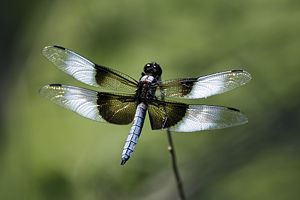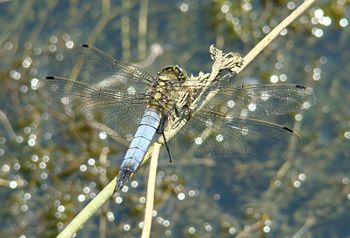Dragonfly: Difference between revisions
imported>Igor Grešovnik |
imported>Igor Grešovnik m (→Adults) |
||
| Line 50: | Line 50: | ||
They have two pairs of similarly sized long thin membranous wings. The [[hindwing]] is broader than the forewing. Both pairs of wings usually have a [[pterostigma]] (a dark or coloured patch near the eing tip) and a mass of cross veins giving them the appearance of being a mesh. There are five main vein stems. Veins are fused at wing bases. A Nodus is formed where the second main vein meets the leading edge of the wing. Almost all dragonflies settle with the wings held out sideways or slightly downward (except in one genus - Cordulephya). | They have two pairs of similarly sized long thin membranous wings. The [[hindwing]] is broader than the forewing. Both pairs of wings usually have a [[pterostigma]] (a dark or coloured patch near the eing tip) and a mass of cross veins giving them the appearance of being a mesh. There are five main vein stems. Veins are fused at wing bases. A Nodus is formed where the second main vein meets the leading edge of the wing. Almost all dragonflies settle with the wings held out sideways or slightly downward (except in one genus - Cordulephya). | ||
Unlike most insects, Dragonflies can flap or beat their wings independently, which | Unlike most insects, Dragonflies can flap or beat their wings independently, which gives amazing manoeuvring capabilities. They can hover or fly backwards, quickly change flight direction and accelerate heavily. Larger species can easily reach 10 m/s (36 km/h), and the Austrophlebia costalis has been reported to reach 16 m/s (58 km/h) for short periods. Average cruising speed is usually somewhere around 4.5 m/s (16 km/h or 10 mph). Due to large wing surface, the dragonflies flap their wings relatively slowly, up to 30 beats per second. | ||
===Larvae=== | ===Larvae=== | ||
Revision as of 19:44, 22 July 2008
| Dragonfly | ||||||||||||||||||
|---|---|---|---|---|---|---|---|---|---|---|---|---|---|---|---|---|---|---|
 (CC) Photo: John Wright
| ||||||||||||||||||
| Scientific classification | ||||||||||||||||||
| ||||||||||||||||||
| Families | ||||||||||||||||||
|
Dragonflies are insects belonging to the order Odonata, the infraorder Anisoptera. They are characterized by an elongated body, two pairs of strong, usually transparent wings, and large multifaceted eyes. Eyes touch in most species. Wings are held perpendicular to the body when at rest. Hindwings broaden near the base. The last three features can be used to distinguished dragonflies from damselflies.
Characteristics
Adults
The head is large, concave behind, on a flexible neck. The compound eyes are large and usually fused along the mid-line at the top of the head. The head carries strong and sharp biting mouthpartsused to cut up prey, three ocelli and a pair of short antennae.
The prothorax is small, the mesothorax and metathorax are large and fused into a single, strong pterothorax. Legs are and adapted for perching and holding prey. They are in generally not used for walking.
The abdomen is elongated and flexible, with ten segments, and ends in clasping organs. Females of several families carry a prominent ovipositor under abdominal segments 9 and 10. Males have secondary genitalia under the abdominal segments 2 and 3.
They have two pairs of similarly sized long thin membranous wings. The hindwing is broader than the forewing. Both pairs of wings usually have a pterostigma (a dark or coloured patch near the eing tip) and a mass of cross veins giving them the appearance of being a mesh. There are five main vein stems. Veins are fused at wing bases. A Nodus is formed where the second main vein meets the leading edge of the wing. Almost all dragonflies settle with the wings held out sideways or slightly downward (except in one genus - Cordulephya).
Unlike most insects, Dragonflies can flap or beat their wings independently, which gives amazing manoeuvring capabilities. They can hover or fly backwards, quickly change flight direction and accelerate heavily. Larger species can easily reach 10 m/s (36 km/h), and the Austrophlebia costalis has been reported to reach 16 m/s (58 km/h) for short periods. Average cruising speed is usually somewhere around 4.5 m/s (16 km/h or 10 mph). Due to large wing surface, the dragonflies flap their wings relatively slowly, up to 30 beats per second.
Larvae
Life cycle
Mating
Eggs
Mating
Larvae
Adults
Taxonomy
Dragonflies in culture
See also
External links
- British Dragonfly Society
- Odonata at the Tree of Life web project
- Gordon's Odonata page
- Digital Dragonflies
- Worldwide Dragonfly Association
- International Dragonfly Fund (IDF) - a society promoting dragonfly research and protection.
Photo galleries
- DragonflyPix - a number of high quality photographs, mostly taken in Italy, also sorted by species
- Dragonflies and Damselflies photo gallery
- [http://www.brocross.com/dfly/dfspec.htm Cheshire Dragonflies & Damselflies
Species List]
Bibliography
Philip S. Corbet. Dragonflies: Behavior and Ecology of Odonata. Cornell University Press, 1999. ISBN 978-0801425929.
Rosser W. Garrison, Natalia von Ellenrieder, Jerry A. Louton. Dragonfly Genera of the New World: An Illustrated and Annotated Key to the Anisoptera. The Johns Hopkins University Press, 2006. ISBN 978-0801884467.
Richard E. White, Donald J. Borror, Roger Tory Peterson. A Field Guide to Insects. Houghton Mifflin, 1998. ISBN 978-0395911709.
Integrated Taxonomic Information System.
Sidney W. Dunkle. Dragonflies through Binoculars: A Field Guide to Dragonflies of North America. Oxford University Press, USA, 2000. ISBN 978-0195112689.
Dragonflies (Wild Guide). Cynthia Berger, Amelia Hansen. Dragonflies (Wild Guide). Stackpole Books, 2004. ISBN 978-0811729710.
Forrest L. Mitchell, James L. Lasswell. A Dazzle of Dragonflies. Texas A&M University Press, 2005. ISBN 978-1585444595.
